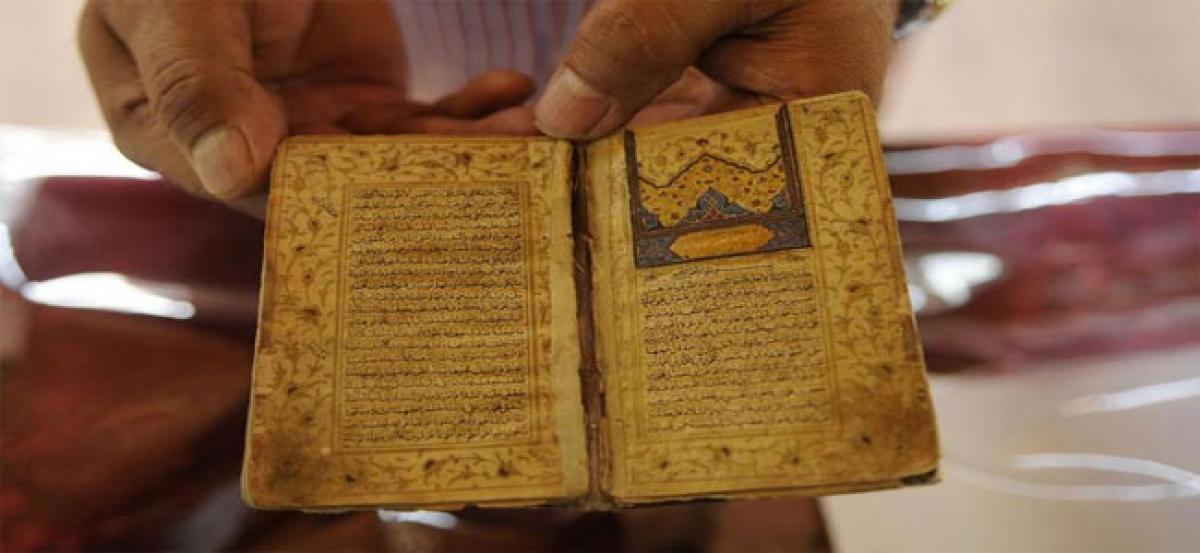Live
- Amazon Great Indian Festival 2024: Best Printers to Buy Under Rs 20,000
- RG Kar scam: CBI gets clues of Sandip Ghosh illegally awarding contracts to biz entity
- Malvika Bansod loses to Akane Yamaguchi in China Open quarterfinals
- Natural farming team invited to Mexico
- Flood-hit urged to avail loan rescheduling
- 400 women’s cases resolved in AP: Women’s Commission
- Centre allocated Rs 250 cr under the SASI: Durgesh
- 12,000 new agri power connections given: Gottipati
- Rs 6,585 cr released to develop 7 national highways
- Munirathna arrested again
Just In

A Hindu family’s collection of rare Quranic manuscripts, elegant calligraphic works, and art masterpieces is on display in Srinagar and drawing hordes of people.
A Hindu family’s collection of rare Quranic manuscripts, elegant calligraphic works, and art masterpieces is on display in Srinagar and drawing hordes of people.
An exhibition of rare Quranic manuscripts, elegant calligraphic works, and art masterpieces is drawing hordes of people and behind all of it is a Hindu family. Suresh Abrol, the man who has painstakingly preserved these valuable manuscripts, says these are part of his grandfather Lala Rekhi Ram Abrol’s collections.
“He was a jeweller in the court of Maharaja Hari Singh, the last Dogra ruler, and collected many of these items. My father sought only one thing in inheritance — these ancient manuscripts and other collections. We consider them our real inheritance,” he says.
The exhibition, titled Shireen Qalam, has been organised by the JK Academy of Art, Culture and Languages, in association with the Department of Tourism and the Indian National Trust for Art and Cultural Heritage, at the Tourist Reception Centre building. It will be on display for the public till June 11.
Over a hundred rare Quranic manuscripts, including Nuskha Fatehullah Kashmiri written by Fatehullah Kashmiri in 1238 AD, exquisite calligraphic works, and remarkable art objects are on display. Nuskha Fatehullah Kashmiri is the oldest available Quran manuscript in Kashmiri calligraphy.
Other manuscripts that attract visitors’ attention include the copy of the holy book dating back to 1594 AD, and considered to be the only sample in the world written in saffron ink. “Our family has 250 Quranic calligraphy collections and 130 of them are on the vellum — a paper made from the skin of goat or camel,” says Abrol.
He says they have brought two handwritten Qurans — one on a four-and-a-half feet by five feet cloth, and the other on a five-feet paper. Shajrah- e-Nasab of Prophet Muhammad, which is about 24-feet-long, with pure gold illumination also adorns the walls of the TRC building. The family also has a laboratory to take care of 5,000 manuscripts written in Arabic, Persian, Sharda, Ayurveda and Sanskrit.
Abrol and his two brothers have converted their home into a museum. They look after the collection and are provided guidance by the state culture ministry. “We spend our own money for their preservation. This is our passion,” he says.
This marks the first time that the collection has been taken out of the house. “It was the state’s cultural department’s suggestion,” he adds.
The calligraphy section features artworks by renowned artists and the exhibition offers a glimpse into rare Islamic manuscripts. One of them is Sad Pand Luqman of Hakim Luqman, which is a Persian manuscript by Peer Baksh of Punjab. A Quran dated 961 AH (roughly 1553), which is handwritten on Samarqandi paper, and a Persian translation of the Quran by Mir Saeed Andrabi in 1850 are also on display.

© 2024 Hyderabad Media House Limited/The Hans India. All rights reserved. Powered by hocalwire.com







